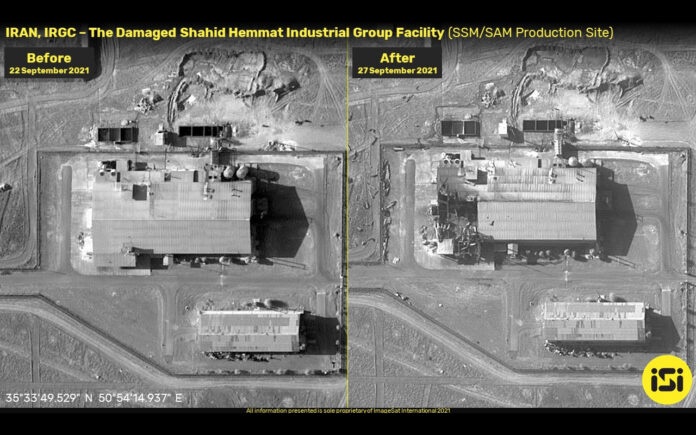
Israel Targets Iranian Military Sites in Precision Airstrikes, Impacting Missile Production and Nuclear Legacy Facilities
In a significant escalation, Israel conducted a series of targeted airstrikes on Saturday, hitting key military and missile production sites in Iran, including the Parchin military complex and the sprawling Khojir missile facility near Tehran. According to assessments based on satellite imagery by David Albright, a former U.N. weapons inspector, and Decker Eveleth, a research analyst at the Washington-based CNA think tank, the strikes may have significantly hampered Iran’s ability to mass-produce missiles.
Targeted Facilities and Impact on Iran’s Missile Production
The airstrikes reportedly damaged buildings associated with solid-fuel mixing, an essential process in the production of ballistic missiles. Albright and Eveleth confirmed that key structures in Parchin and Khojir, where these operations were conducted, were hit. Planet Labs satellite imagery analyzed by Eveleth revealed that three ballistic missile solid-fuel mixing buildings and a warehouse were destroyed in Parchin. At Khojir, two additional buildings designed for similar activities were also demolished. The images showed that these structures were surrounded by high dirt berms—an indication of high-risk missile production sites, meant to contain blasts and prevent chain detonations.
“Solid-fuel mixers are challenging to manufacture and subject to strict export controls,” Eveleth noted. “Iran invested heavily in importing these over the years and replacing them will be difficult.” He added that the strikes likely delivered a serious blow to Iran’s missile manufacturing capabilities, limiting the country’s ability to rebuild its missile stockpile and complicating future missile attacks on Israel.
Parchin: Legacy of Iran’s Defunct Nuclear Program
One of the facilities targeted at Parchin was identified as Taleghan 2, a building previously used for nuclear weapons-related testing under Iran’s now-defunct Amad Plan. David Albright, head of the Institute for Science and International Security, pointed out that Israel’s strike damaged three buildings near Taleghan 2, including those involved in solid-fuel mixing. While Iran officially shuttered its nuclear weapons program in 2003, documents obtained by Israel’s Mossad in 2018 revealed that equipment used during the Amad Plan was stored at Taleghan 2.
Albright suggested that while Iran may have removed sensitive equipment before the strike, the building still held intrinsic value for potential future nuclear-related activities. “Even without equipment inside, the structure itself could have supported further weapons development,” he remarked.
Iranian and Israeli Responses
The Israeli military confirmed the strikes, stating that three waves of jets targeted missile factories and strategic sites in retaliation for Iran’s October 1 barrage of over 200 missiles against Israel. Iran, in turn, accused Israel of deploying “very light warheads” to hit radar systems along the border regions of Ilam, Khuzestan, and areas near Tehran.
The targeted strikes reflect Israel’s ongoing efforts to preempt threats from Iran, which possesses the largest missile arsenal in the Middle East. U.S. officials have long expressed concerns about Iran’s missile exports to groups like Yemen’s Houthi rebels, Hezbollah in Lebanon, and even to Russia for use in the conflict against Ukraine. Both Iran and Russia deny the transfer of Iranian missiles for the war in Ukraine.
Strategic Blow to Iran’s Missile Capabilities
Israel’s precision targeting appears to have been designed to degrade Iran’s missile production capacity. According to Axios, 12 “planetary mixers”—specialized industrial equipment used for solid-fuel production—were destroyed in the attack. Israeli sources claimed that this damage would severely restrict Iran’s ability to rebuild its missile stockpile and serve as a deterrent against further missile attacks on Israel.
“This limited operation has likely dealt a significant blow to Iran’s missile production efforts,” Eveleth said. “It may also make it harder for Iranian missiles to breach Israel’s missile defense systems in the future.”
Iran’s Expanding Military Complexes
Earlier reports indicated that Iran has been expanding its missile production infrastructure. Satellite imagery reviewed by Eveleth and Jeffrey Lewis of the Middlebury Institute of International Studies identified significant developments at the Khojir and Modarres military complexes, suggesting preparations for increased missile production. These expansions align with concerns raised by U.S. and allied intelligence agencies about Iran’s growing missile capabilities and regional influence.
Three senior Iranian officials confirmed the assessment that Iran’s missile facilities have been rapidly expanding to boost production capacity. However, the recent Israeli strikes could disrupt these efforts, at least in the short term, further escalating tensions in the region.
Conclusion
The targeted strikes by Israel underscore the heightened conflict between the two nations, with Israel aiming to curb Iran’s missile capabilities and limit any revival of nuclear-related activities. While the precise long-term impact of the strikes is yet to be seen, the destruction of critical missile production infrastructure represents a tactical victory for Israel, with potential implications for regional security dynamics. Iran’s next steps—diplomatic, military, or strategic—will likely shape the trajectory of this intensifying conflict in the coming weeks.
